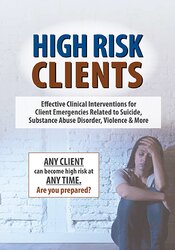High Risk Clients: Effective Clinical Interventions for Client Emergencies Related to Suicide, Substance Abuse Disorder, Violence & More, 15/12/2022 00:00:00 South Africa Standard Time, Online Learning More info »

High Risk Clients: Effectively Handle Five of the Most Critical Scenarios You’ll Face as a Clinician
Credit Available - See CEUs tab below.
- Categories:
- Suicide and Self-Harm
- Faculty:
- Paul Brasler, LCSW, CAIMHP
- Duration:
- 6 Hours 14 Minutes
- Format:
- Audio and Video
- Original Program Date:
- 18 Apr, 2018
- SKU:
- POS049335
- Media Type:
- Online Learning - Also available: Online Learning
Description
Crises are never scheduled, convenient or easy. But they do happen and you will face them. Clients at risk for crisis often present with so many symptoms and issues, it’s hard to know where to start. Many clinicians, anxious about how to proceed, often miss or avoid asking the right questions to effectively intervene and keep clients (and themselves) safe.
As a clinician, have you ever felt:
- Worried about the safety of your clients, even feared for their lives, but felt unprepared to handle the situation?
- Unsafe in the clinical environment, or unsure of how to handle situations where someone connected to your client might be in danger?
- Caught off guard when you’re wrapping up a session and a client discloses suicidal thoughts?
- Unsure if a client was using drugs, and ill equipped to identify the signs and symptoms of drug abuse?
- Concerned that you’re doing more harm than good for traumatized clients, despite your best intentions?
In this recording, Paul Brasler, LCSW, navigates you through five of the most difficult scenarios in mental health today. Through real-life examples and live role plays, Paul will share the concrete strategies that he’s used over the last two decades to safely and effectively intervene in the challenging, urgent, and sometimes alarming situations that mental health professionals face. Full of practical tools and tips, this recording will teach you to how to make crises situations more manageable, overcome your worries, and improve your readiness to handle mental health emergencies related to suicide, violence, substance abuse, trauma, and medical issues.
Better still, instruction on professional liability management techniques, tips for documentation, and detailed reproducible assessment forms will have you feeling confident that you can focus on doing what’s best for your clients without fear of litigation. And, Paul’s guidance is applicable to your work regardless of your setting or clinical background.
You'll be left feeling equipped to help your most vulnerable clients with the real-life skills and knowledge they don’t teach in graduate school!
CEUs
This course is available for 6.25 total CPDs.
The HPCSA has declared that any on-line courses CPD/CEU credited by a certified US board, is automatically CPD/CEU credited in South Africa.
As there are different boards for different disciplines, we at Acacia suggest that you use the Counselling CPD/CEU credits. These correspond to South African credits of one CPD/CEU per 60 minutes. If you choose to use your discipline's credits, please do so at your discretion.
PESI, Inc. is an approved provider with the Florida Board of Clinical Social Work, Marriage and Family Therapy and Mental Health Counseling. Provider Number 50-399. This self-study course qualifies for 6.25 continuing education credits.
Handouts
| File type | File name | Number of pages | |
|---|---|---|---|
| Manual (4.80 MB) | 80 Pages | Available after Purchase | |
| Manual: Module 1 - 6 Suicidal and High-Risk Clients - French (4.80 MB) | 80 Pages | Available after Purchase | |
| Manual: Module 1 - 6 Suicidal and High-Risk Clients - Italian (4.80 MB) | 80 Pages | Available after Purchase | |
| Manual: Module 1 - 6 Suicidal and High-Risk Clients - German (4.80 MB) | 80 Pages | Available after Purchase | |
| Manual: Module 1 - 6 Suicidal and High-Risk Clients - Spanish (4.80 MB) | 80 Pages | Available after Purchase |
Faculty

Paul Brasler, LCSW, CAIMHP Related seminars and products
Paul Brasler, LCSW, CAIMHP, became a licensed clinical social worker in 2002. Paul is the coordinator for the Chesterfield County (Virginia) Employee Behavioral Health Program, through which he and his team provide clinical services to first responders and human services personnel. He has extensive experience working with people in crisis and people living with substance use disorders, including adolescent residential treatment, community mental health settings, hospital emergency departments, juvenile drug court, and private practice.
Paul has been a national presenter (through PESI) since 2016, and he has presented classes across the country on mental health emergencies, high-risk clients, resiliency, and a certification course for clinicians working with people with substance use disorders. He has written three books: The Clinician’s Guide to Suicide Management, PESI Publishing, 2025; The Clinician’s Guide to Substance Use Disorder, PESI Publishing, 2022; and High-Risk Clients, PESI Publishing, 2019. Paul lives in Richmond, Virginia, with his beautiful wife, three sons, cowardly dog, and two dwarf rabbits who are quietly plotting to destroy the world.
Speaker Disclosures:
Financial: Paul Brasler maintains a private practice and has an employment relationship with Chesterfield County. He receives a speaking honorarium, recording, and book royalties from Psychotherapy Networker and PESI, Inc. He has no relevant financial relationships with ineligible organizations.
Non-financial: Paul Brasler has no relevant non-financial relationships.
Alternate Options
|
High Risk Clients: Effective Clinical Interventions for Client Emergencies Related to Suicide, Substance Abuse Disorder, Violence & More
Original Program Date: 15/12/2022 - SKU POS049335 |
Additional Info
Program Information
Access for Self-Study (Non-Interactive)Access never expires for this product.
Target Audience
Counselors, Social Workers, Psychologists, Case Managers, Addiction Counselors, Marriage & Family Therapists, Nurses, Nurse Practitioners, and other Mental Health ProvidersOutline
- Client Assessment: Ask the Right Questions
- Conduct comprehensive assessments
- Mini mental status exam
- Lethality assessment: Suicide and homicide
- Substance use assessment
- Trauma assessment
- Tips and strategies for eliciting the right information
- Conduct comprehensive assessments
- The Suicidal Client: More than 13 Reasons Why
- High-risk populations—who is most at risk?
- Implicit and explicit expressions of suicidal ideation and intent
- Self-injurious behavior and suicidal ideation
- Suicide assessment and interviews: Ideation, plans, means, intent
- What do I do now? —Disposition & safety planning
- Why “No-Harm Contracts” are harmful
- Breaking client confidentiality
- When in doubt, do what?
- Hospitalization process
- After the ER: When clients are not admitted
- Case studies:
- Michelle—Teenagers experiencing suicidal ideation
- William—The intersection of substance use, mental illness and suicidality
- The Violent Client: Manage Dangerous Situations
- Dealing with our fears: Clinicians’ safety concerns
- When the clinician is the target
- When others are the target
- De-escalation techniques
- Preventative planning
- Office layout
- Keeping good boundaries
- Police involvement before a crisis
- Safety planning
- When to call 911
- Hospitalization process
- Duty to warn
- Case studies:
- George—Handle a violent client
- Dale—Practice Duty to Warn
- The Addicted Client: What ALL Clinicians Need to Know
- How misdiagnosis harms clients
- Signs of intoxication
- Imminent risk: Signs and symptoms of overdose
- Identify withdrawal syndromes
- Accurate diagnosis and treatment matching
- Drug basics that clinicians should know:
- Opioids and the opioid crisis (heroin, fentanyl and emerging drugs)
- Stimulants (cocaine, “bath salts,” methamphetamine)
- Cannabinoids (“shatter,” spice)
- Other chemicals (DXM, “Special K,” Ayahuasca)
- When and how to refer to a higher level of care
- Case studies:
- Percy—Opioid crisis in the waiting room
- Cathy—Bipolar Disorder? Think again
- The Traumatized Client: Help Without Hurting
- Recognize trauma in clients
- The risk of misdiagnosis
- Dangers of improper treatment
- Strategies for trauma-informed care
- First and foremost: Safety inside and outside the clinic
- The role of mindfulness
- Go slow…but go
- Understand Levels of Safety
- Triune Brain Model and trauma
- Bereavement: Not always trauma
- The intersection of trauma, mental health, substance abuse and medical problems
- Case studies:
- Brian—Trauma missed
- Mick—“How deep can I bury this?”
- Medical vs. Psychiatric Problems: Limiting Harm
- “What Could Kill the Patient First?”
- Collaborative care with primary physician
- Medical emergencies that present with psychological symptoms
- Signs and symptoms: Limit client harm by recognizing a medical emergency
- Medication-Related Disorders
- Traumatic Brain Injury (TBI)
- Neurocognitive Disorders
- Other Neurological Illnesses
- Case studies:
- Steven and the Zombies—Organic disorders
- “Granny has schizophrenia!”
- High Risk Clinicians: After the Crisis
- Protect your license and manage liability
- Documentation: What you need to know
- Debriefing and supervision
- Vicarious trauma
- Addressing compassion fatigue
- Case study:
- Dave and me
-
Limitations and Potential Risks
- Limited controlled studies
- Seek supervision when necessary
- Weigh out risk of intervening versus not intervening
Objectives
- Complete a comprehensive mental health assessment that encompasses a multitude of clinical concerns including mental status, lethality, substance abuse and trauma.
- Identify signs of and risk factors for suicidal ideation in clients and effectively respond in order to ensure the safety of the client.
- Recognize indicators of substance intoxication, withdrawal and overdose in clients and establish protocol for responding appropriately.
- Assess for risk of violence in a clinical setting and develop skills to effectively and safely intervene during an acute crisis.
- Examine ways in which client responses to trauma are often misdiagnosed as mental health disorders and consider the clinical implications of this.
- Create accurate and comprehensive documentation of clinical crises to protect all.
Please wait ...
